If you ever have a stroke of bad luck and accidentally punch or tear your canvas painting, don’t patch it up. Holes and tears in stretched canvases can happen and patches can seem like an easy fix but are not recommended. Likewise, adhering labels with information about the painting on the reverse is generally a good practice, but the label should not be placed on the canvas itself.
Distortions
The reason why patches and labels are simply not a good idea is planar deformation. Planar simply means a flat surface or plane and translated to canvas paintings planar deformations refers to distortions such as bulges or plateaus. These are a common consequence of gluing patches or labels to the back of canvases. Their outlines can become visible as distortions, on the front of the painting and thus disturb the aesthetic of a piece.
Different Adhesives:
Patches are never a great solution, but one of the worst choices for a glue would be animal glues such as hide glue or fish glue. Animal glues are greatly appreciated for their tightening effect when used as a size in canvas preparation, but this effect exacerbates planar canvas deformations when used for patches (Image 1). Additionally, animal glues are extremely hygroscopic and will cause the canvas fibers to swell and shrink as the temperature and humidity levels rise and fall, thus adding to the problem. Compared to our test with animal glue (rabbit skin glue), acrylics (Soft Gel Gloss) caused less planar deformation (Image 2), and our test with microcrystalline wax also caused less deformation than the animal glue (Image 3).

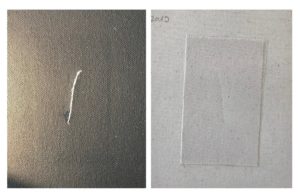
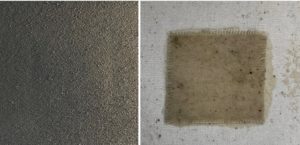
Priming and Paint Layers:
Distortions can occur regardless of the type of priming and paint layers. We tested cotton canvas prepared with acrylic gesso and painted with a number of layers of Fluid Acrylics (Image 4), as well as a linen canvas prepared traditionally with rabbit skin glue size and Williamsburg Oil Ground (Images 5 & 6). Between the two patches on the linen canvas the one adhered with animal glue caused again, greater planar deformations, as can be seen in the raking light images.
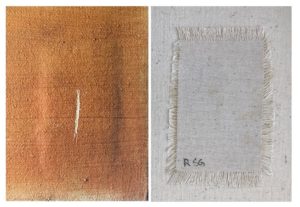

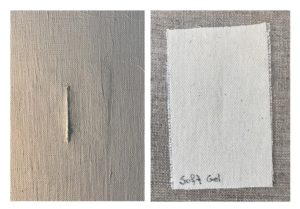
Synthetic Canvas vs Natural Fiber Canvas:
Patches on synthetic canvas can distort just as much as on natural fiber canvases. In our tests we applied two patches to a polyester canvas. For one patch we used Rabbit Skin Glue (Image 7) and for the other patch, Soft Gel Gloss (Image 8). The patch adhered with the Soft Gel caused significantly less deformations.
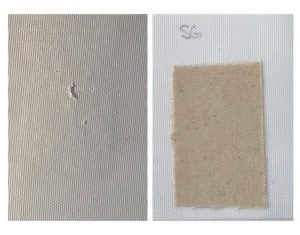

Feathering Out Edges:
Feathering out the edges of a patch theoretically can help to reduce distortions, but I have seen many patches on old paintings with significant distortions, despite feathered edges. The idea is to create a gradient transition of stresses from the patch outwards into the rest of the painting, so that the outlines of the patch would not transfer to the front. However, if the patches consist of thick and stiff enough materials and the adhesive is applied thickly, feathering out edges does not always prevent planar deformations, as can be seen in Image 9 and in Image 4.

All or Nothing:
Nothing should be glued to the back of a painting, unless it covers the entire surface, including the space underneath the stretcher bars. Sparing out the space underneath the stretcher bars can lead to distortions just like those caused by patches (Image 10).
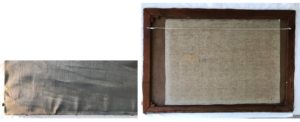
Expect Updates on Our Tests:
Even if deformations are not noticeable right away, they might develop over time. We are planning on reassessing and photographing the same canvases again in one year’s time and posting the results in this article.
Recommendations
- Information labels on the reverse of a painting can give valuable information to future collectors or conservators. These labels could list not only the dates of when the painting was started and completed, but also about the materials used and their layering, especially final varnishes. These labels can be attached to the reverse of stretcher bars or the information can be written with permanent and lightfast pens directly on stretcher bars, but not on the canvas itself. Writing directly onto the reverse of a canvas is not something we recommend, as the ink from markers or pens might migrate through to the front over time and the pointed pressure of a pencil could cause impact damage.
- Use backing boards to significantly reduce the risks of punch holes and tears in your canvas paintings. Informative labels can also be placed on backing boards instead of stretcher bars. You can find more information on backing boards in our article Backing-boards for canvas paintings.
- In case you have a painting which you painted yourself and consider treating it yourself for a tear or a hole, feel free to reach out to our Material and Application Department for tailored advice in your situation.
- If you have a painting made by somebody else or the affected painting is your own work but is sold already, our best advice is to find a Conservator. Painting Conservators are trained to do tear mending and placing inlays, which are a much safer way to treat such damages. Conservators are also better equipped to remove patches and correct distortions, or find other appropriate treatments for your painting, although not all patches are reversible. You can use the website of the AIC to find a local conservator.
As always, if you have any concerns or questions, feel free to contact us through phone or email.
Further Links:
- JP article on Backing-boards for canvas paintings.
- MITRA (The Materials Information and Technical Resources for Artists): https://www.artcons.udel.edu/mitra/Documents/MITRA_Storage_Exh_Handling.pdf
- AIC (American Institute for Conservation) find a conservator: https://www.culturalheritage.org/about-conservation/find-a-conservator
- JP article on Using Oils with Acrylics demonstrates the responsiveness of various materials to changing environments.
About Mirjam Auf der Mauer
View all posts by Mirjam Auf der Mauer -->Subscribe
Subscribe to the newsletter today!
No related Post

Hello
My idea is to attach a patch on its bias. Could that possibly be a solution that could work? Has anyone tried? Perhaps it would blend in with the painting in a more organic way as well.
Hello Heidi,
Thank you for sharing your thoughts here. We have not tested placing a patch with its weave direction at a 45° angle to the canvas, but would think it would not improve the situation. If you wish to try it, we recommend using a test canvas.
Baumgartner Restoration has covered this topic in great detail. The BR YouTube channel is compulsory viewing for people who want to know – or think they know – about restoring fine Art.
I’ve seen tear repairs done by a series of linen threads* ( I think of uneven length.) glued with space separations across the broken surface. I believe the tear being carefully edge glued first with the extra threads glued for added strength. From memory I think these might be called ‘bridge repairs’. With there not being an unbroken patch of cloth, there’s less of a solid shape to telegraph through to the front. If not your own work, best done by an expert.
* Knut Nicolaus; ‘Restoration Paintings’ published 1999
Hello Mark,
Yes, that is one way of doing tear mending and not uncommon. Thank you for your comment.
Art restorers repair damage, so it is possible. Just that the correct methods of how to correctly repair are not being shared.